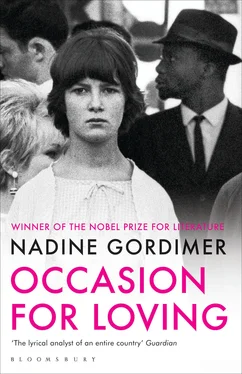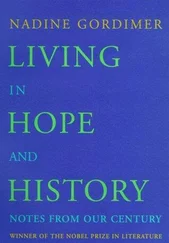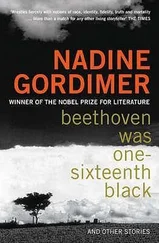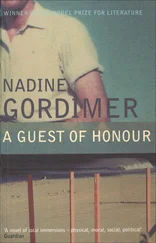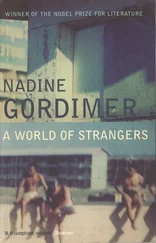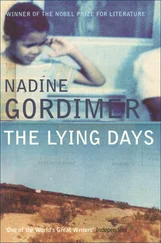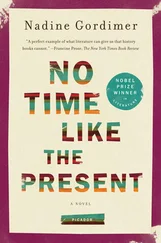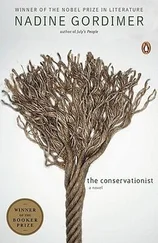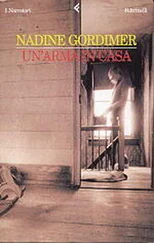“Why is he so vague. He seems to take a delight in never quite knowing anything,” she said, irritated, to Tom.
“He’s afraid of being wrong, I should say.”
“Jessie, did you really live in a place just like this?” Ann leaned in the car window.
“I did.” She added to Tom as they drove on, “Bruno used to take me to see the boys dancing sometimes on a Sunday. We just walked across the veld from our house to the compound.”
“I can’t imagine Bruno doing an ordinary fatherly thing like that.”
Jessie watched the tall gum-trees, the brick bungalows behind their hedges, the traffic circles filled with marigolds, as they drove through mine property. A candle, taken down into the past, swiftly threw light over the bulk and outline of what lay there; and then passed on, to be quenched by daylight.
The cars skirted the compound — a rectangular barracks that presented blank walls to the outside world, and had all its life turned inward towards the quadrangle it enclosed — and came to a scene rather like a fair. A black man who filled out some sort of uniform with the afflatus of officialdom waved them to a level, grass-grown ground where a great many cars were already parked in neat rows. There were two flags flying; the restlessness of a close gathering was in the air. They trailed over the grass and up whitewashed steps to an amphitheatre partly covered by thatch. There were knots of white people about, wearing their city people’s fancy holiday clothing — the tight linen trousers, the dark glasses and bright shirts — and others with cameras were prowling and peering. Past a rope barrier there was a less homogeneously-dressed crowd of various kinds and colours — Indian families with their profusion of daughters, all pink and yellow nylon, and plaits of oiled black hair, city Africans with bicycle clips on their trousers and Bermuda straw hats with paisley bands on the backs of their heads, mine-workers who had strolled over from the compound but brought with them from much further off the faces, hairdress and blankets or ornaments of other countries in Africa. Just round the elliptical curve of the amphitheatre, on the left, duster-feathers waved; the backs of another crowd hid groups of dancers who were warming up in preparation for their appearance. There was a small rustic building marked REFRESHMENTS — ALL PROCEEDS TO NATIVE CHARITIES, and a white man at a table under an umbrella gave out programmes.
It was all perfectly neat and clean and orderly. No need for the American and German tourists who, under their guide, obediently occupied a special block of seats, to fear contamination, embarrassment, or the heat of the sun. The Stilwell party filed in where they could; the shadow of the thatch dropped upon them, making them part of the drowned brightness, the blue-dimmed whiteness of those tiers where the white people sat. A hanging garden of faces — black and shining, on the far side of the little amphitheatre — looked on a tarred arena, black where the shade fell upon it; in the sun, a yellow slice of lemon thrown down, startling.
The party twisted and chattered; Ann studied the programme notes and her questions and comments darted like swallows. Boaz kept saying to her, or explaining to other people that he had said to her, “You must realise that you’re not seeing the real thing at all.” “Oh I know, I know. I don’t expect it,” she said, the obedient pupil. But she was not ashamed of her eagerness to see the dancing, anyway.
“If they dance, and they enjoy it, why isn’t that real?” A heavy-faced dark girl spoke crossly.
Tom said, “What Boaz means is that these dances are usually part of elaborate ceremonies. Here you see them just as fragments, lifted out of their context.”
“And changed!” someone added. “Hotted up to please the audience. They’ve learned to make a performance of themselves.”
“The best one’s the gum-boot dance. You’ll love that.”
People related, as people will, unique and wonderful chances by which they had seen the real thing.
“But it’s nothing to do with the Chamber of Mines,” Boaz was protesting. “The blacks have always done it. The only difference is, it didn’t used to be organised for white people to come and watch. Jessie — isn’t that right?” The argument deferred to her. “When you saw these dances as a child,” Boaz asked her, “do you remember — what sort of impression did they make?” “Very little,” said Jessie, with a laugh. She thought a moment. “I don’t know. You know, the mine boys were not human to me. — Like a cage full of coloured parrots, screeching at the zoo. I watched them dancing and I walked home and forgot about them.” The black-haired girl raised her eyebrows and looked the other way; she had recently discovered the distinction of professing no colour feeling; she was surprised to find such things said among people in a set she aspired to — she had indeed adopted her present views because she wanted to join it.
Jessie sank into the pleasant, Sunday mood of the crowd; the talk and argument of her friends went on half-heard about her, and her consciousness of self was lost, as it sometimes was when she was surrounded by the common mystery of human faces. The backs of men’s necks, the nostrils and mouth of a woman shown beneath the brim of a hat, a young girl tossing back her yellow hair as the fly of vanity stung her — Jessie’s consciousness became variously these, as the shadow of a cloud, travelling over a landscape, becomes now the shape of a hill, now the colour of a lake. When the dancing began, though she said to Clem and Elisabeth, who were giggling and scuffling, “Sit up straight and look,” she herself was not gathered to attention. A portly African in a white coat and glasses put on an easel a board on which the tribal name of the group of dancers was painted; when they had pranced and yelled and stamped for an allotted time, a shrill blast on his whistle cut them short, and they left the arena, while the name of another tribe was set up, and the next group of dancers came in. So the programme went on — sometimes the dancers began languidly, hesitantly, and worked up to a strong, sustained beat just in time to have it brought down, as if by a shot, by the whistle’s blast, sometimes they burst in in the full force of lungs and feet, and swept out again, undiminished. There were men on stilts who wore, rendered harmless by reproduction in cardboard and poster-paint, the terrible fetish-faces of medicine men’s masks. There were comedians, hoarse, noisy and tumbling, with the ugly faces of all clowns everywhere, who played to the black gallery, where their quips were understood and brought derisive yells and laughter. There was a choir in white drill pants and satin cowboy shirts who sang while their leader, wearing fringed chaps and boots, released and captured again a small cage of cowed white rats. Now and then the parody of the white man’s voice, yelling an order in the jargon of the mines, sent a murmur of delighted recognition through the white audience, who did not know in what light they were being represented, but were glad to be mentioned anyway. Many of the dances were pyrrhic, and the audience and the performers liked these best. With bits of coloured rag tied to old bathing-trunks, lemonade bottle-tops making do for anklets round the legs of those who no longer had strings of rattling seed-pods, and, in their hands, cow-skin shields and wooden assegais, the black men went through the savage motions of warring. They jumped and yelled and shuffled ominously; they found, in their breasts and throats, as the dance took them up, that dreadful sighing grunt that belongs to the ecstasy of death dealt out. They stamped so that a ripple of force passed along the ground under the seats of the watchers.
Читать дальше
